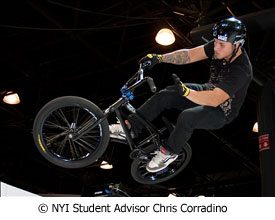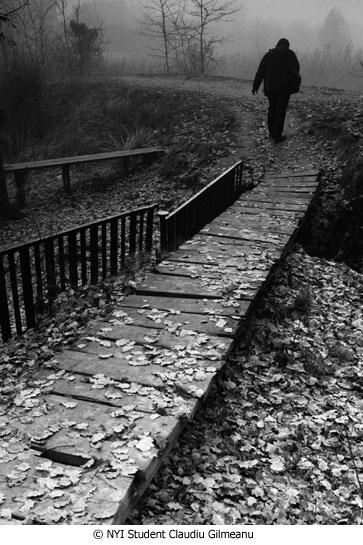Before I begin with the topic of digital studio lighting, I want to correct a misconception about lights for digital capture, especially strobes. Some people think you need special "digital" lights and that equipment used previously with film won't work. The manufacturers have encouraged this thinking with expensive hot shoe-type flashes that sport features designed to "enhance" the digital experience. The Nikon SB-800 and the Canon 580EX are examples that come to mind.
Don't get me wrong. These are fine little strobes and if you have a DSLR that is fully compatible with those "enhanced" features (and don't mind the cost), fine, go for it. But you don't need them and anyway, hot shoe flashes are not really suitable for studio work, the subject of this article.
What kind of lights are suitable? Here we have to distinguish between two basic types of photographic lighting, whether for film or digital — continuous lights and strobes. Continuous lights are those which you turn on and they stay on until you turn them off. Photofloods, a kind of incandescent light source, are of this type. They are inexpensive and easy to use and for this reason we often suggest them to students first getting into studio photography. But photofloods (and their big brother, professional quartz halogen lights) have some serious drawbacks. Heat, for one. They don't call them "hot-lights" for nothing. If you ever touch one while it is still on, I guarantee you won't do it a second time. For another, unstable color temperature; though the quartz lights are better at this, especially if you have a voltage regulator installed on the line. They last longer than the photofloods, but because they are even hotter, there is a potential hazard — the bulb can explode under certainn conditions. It's not that common but because of this, the better units come with a protective screen and/or safety glass.
Another thing to keep in mind is that hot-lights are a very inefficient light source, simply because so much of the power is wasted as heat. This often necessitates the use of relatively slow shutter speeds in order to compensate for the output loss. Not a big problem if you are doing product photography, as long as the product isn't moving. But suppose you want to shoot portraits? People do move, even if it's only their heads, and that means employing an even bigger (and hotter) unit so you'll have access to faster shutter speeds. Yes, you could set a high ISO on your camera, but then you have increased noise to deal with.

However, 600 watt quartz halogen lights are pretty bright and operate under the same principle as regular tungsten bulbs. The difference is the bulbs are made of quartz and are filled with halogen gas. The result is brighter light and longer life. When used with a good-size softbox, like 24 x 24 inches, they will provide nice soft illumination quite suitable for portraiture. These are made by numerous manufacturers, like Lowel, Photoflex, Smith-Victor, and others. If you go this route, be sure the softbox you get is rated for hot-lights, NOT those intended for use with strobes. The hot-light type is made with materials that are very heat resistant and some models are equipped with louvers to vent the heat.
Another issue to consider for digital studio lighting is the wattage. If you are planning a home studio, you'd better have an electrician check out your wiring, especially if it's an older home.
A fairly recent development in continuous photographic lighting is fluorescents, which are cooler and provide nice soft illumination. Because they are cool, you can place them quite close to your portrait subject. They work fine with digital cameras but not so well with film. That's because fluorescents have a spectral distribution that plays havoc with film. If you've ever shot a roll under such lights and got that infamous greenish color cast, you know what I am talking about. Not really an issue with digital but even so, I recommend you shoot RAW for your studio work. The color temperature of fluorescents can change both with the age of the tubes and how long you have them switched on.

Some fluorescent photographic lights have a built-in dimmer mechanism (the more modern studio lights use DMX, a kind of digital controller system). There are types than can be mounted on a stand, but a better approach, in my opinion, is to hang them on a track system overhead. Arri, a well-known manufacturer of lighting gear, offers an extensive line called Studio Cool. Not exactly inexpensive and the tubes are sold separately but such units do provide a nice continuous light source that's cool.
Still more recent is the introduction of lights that use compact fluorescent bulbs, either individually or in an array. Perhaps the best-known is the Bowens 9lite, a kind of soft box with (you guessed it) nine compact fluorescent bulbs. I've used the latter type bulbs in standard household fixtures. They use less electricity than regular incandescent bulbs and last a long time. The Bowens 9lite comes with the bulbs, which is a good thing because they are rather more expensive than the compact fluorescents made for home use.
Some fluorescents are a bit on the cool side, color-wise. The Bowens 9lite, for example, has bulbs rated at 6400K. This is easily adjusted by setting a custom white balance for your camera and even if your camera offers color temperature settings, I think this is the best approach. Shoot RAW and you then have total control over the color.


LED (light-emitting diode) units are another development in digital studio lighting. Also long lasting and cool, they might be an alternative to fluorescents. Litepanels has numerous products, including some that are similar to the fluorescent panels, and their LED's are rated at 100,000 hours! Definitely not cheap, though. Price for a 1 x 1 foot panel was quoted at about $1800 at one vendor I visited.
Are continuous light sources such as these the best choice for a digital studio? If you are on a tight budget, maybe not. Some types, like HMI lights (it stands for Hydrargyrum Medium Arc Iodide, but you don't have to remember that), seem more suitable for video or theatrical use (Hollywood movies are often shot under HMI lights), where a continuous light source is a requirement, not merely an option. However, a decent quartz halogen studio lighting kit, with softboxes, is likely to be much less expensive than fluorescents or LED units. And any continuous source, no matter the type, does offer one big advantage — the lighting kits are easy to set up for portraiture. You can immediately see how the shadows fall. With digital, of course, you can view your shots right away on your camera's LCD monitor in playback mode, then make any lighting adjustments necessary. But unless you have your camera tethered to a laptop (not a bad approach for studio portraiture, by the way), you are going to be making those decisions while looking at a tiny screen. Continuous lights eliminate this cumbersome uncertainty. It's a situation of what-you-see-is-what-you-get.
What are the alternatives to continuous lights? Well, that brings us to strobe lights, the studio type, and in general, shooting digital is no different that shooting with film (there is an exception which I mention below). You are still confronted with a bewildering array of choices when choosing a strobe kit for digital studio lighting. Should you get monolights or a power pack system? Umbrellas or softboxes? How many units do you need? Which flash meter should you buy (yes, you need a hand-held. Forget your in-camera metering system).
Very briefly, monolight strobe units have everything housed in one unit. They are less expensive than power packs and somewhat easier to use. The disadvantage is weight, meaning you need pretty sturdy and heavy light stands to hold them. Manufacturers include Bowens, Elinchrom, Novatron, Photogenic, White Lightning, and a host of others and all are available as studio lighting kits. An offshoot of White Lightning is called Alien Bees (where do they get these names!) that's less expensive. If you are really strapped for cash, SP Studio Systems makes relatively cheap strobe lighting units that are quite adequate and Photogenic offers a budget line of strobe lights called StudioMax.

For established studio photographers, the power pack units might be the best choice, especially if the unit will be put to HEAVY use. That means lots of clients! Power packs typically have two or more sockets to plug in the flash heads. Since the flash heads contain little more than a flash tube, modeling light, and a reflector, they are pretty light, weight-wise, and don't require as sturdy a stand as monolights. All the flashes and functions, including wireless operation, are controlled from the pack, which is plugged into an AC outlet (there are some battery-powered units).Some units allow you to control functions from a computer. All this capability doesn't come cheap, though. For example, the Broncolor Grafit A2 RFS is a 1600 watt/second unit with a host of features, including precise control of flash duration (1/125 to 1/6000sec), fast recycling (as short as .03 seconds), adjustable power in 1/10th or 1/3 stop increments, built-in slave cell, built-in circuit breaker, and (naturally) fan cooled, amongst others. Price? About $6800. The Grafit can also be triggered from a MAC or Windows computer with an optional RFS transceiver and the appropriate software. Nice if you have the money and the need but there ARE less expensive packs.

However, if you are just starting out or have a part-time photography business, I think monolights are a better choice for digital studio lighting. Alien Bees offers some nice, reasonable strobe kits (they call them packages) and one, the Digi Bee, costs only $600. It includes two monolights (not high-powered but more than enough for a small home portrait studio), two 10 ft light stands, two 48 in umbrellas, and a carry case. Alien Bees describes the "Digi" as suitable for digital photographers who don't need a lot of power. And you won't if you shoot at 400 ISO, quite practical with most DSLR's. That's the only thing "digital" about the "Digi". But you can also buy components separately for a more custom fit.
Are there any digital cameras that won't work with strobes. Well, yes, but if you happen to have one, you undoubtedly already know about this. Large format cameras that employ a digital scanning back require a continuous light source instead of strobes.
Perhaps you are wondering why you can't use one or more portable hot shoe-type flashes for studio photography. Well, you can but there are limitations. The main one is a lack of a modeling light. Some expensive models have a kind of modeling light that stays on for a brief period but that's not the same thing as what's available in real studio strobes. They are ok, however, for location work as long as you are not trying to illuminate a large subject and they to have the advantage of light weight in a small package. But once again, you don't need the newest high-end flash made by your DSLR's manufacturer.
I've not discussed HOW to use these different types of illumination for studio photography. I've said nothing about placement, setting lighting ratios, or any of the other technical considerations every studio photographer must know. Nor have I said anything about basic photography. If you already have a studio and are looking to upgrade some of the components, or if you are just starting out in studio work, I assume you already know the basics. If not, I recommend you take our Complete Course in Professional Photography. The Course has extensive sections on studio lighting.
Learn all about studio lightning and the best photography equipment at NYIP Photography School






